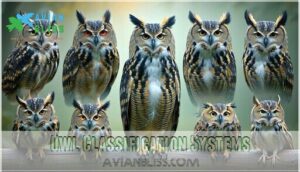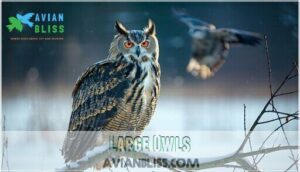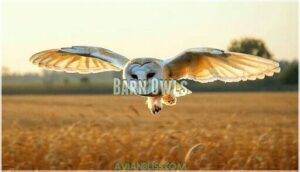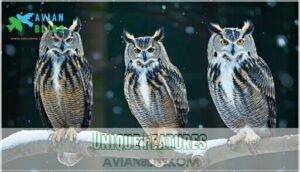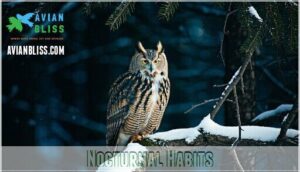This site is supported by our readers. We may earn a commission, at no cost to you, if you purchase through links.
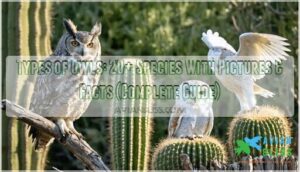 You’ll find over 200 types of owls across the globe, each perfectly adapted to their unique environments.
You’ll find over 200 types of owls across the globe, each perfectly adapted to their unique environments.
From the tiny elf owl that weighs less than a golf ball to the powerful great horned owl with its signature ear tufts, these nocturnal hunters showcase remarkable diversity.
Barn owls sport heart-shaped faces and ghost-white plumage, while screech owls master the art of camouflage with their bark-like patterns.
Some species prefer dense forests, others thrive in open grasslands, and a few even hunt during daylight hours.
Each owl’s specialized features—from silent flight to asymmetrical ears—reveal nature’s ingenious solutions for different hunting challenges and habitats.
Table Of Contents
- Key Takeaways
- Owl Species Overview
- Owl Classification Systems
- Types of Owl Species
- Owl Characteristics
- Owl Conservation Status
- Frequently Asked Questions (FAQs)
- How many types of owls are there?
- How many owl species are in the Strigidae family?
- How do you classify owls?
- Which owl species are in the order Strigiformes & Tytonidae?
- What order do owls belong to?
- Which owl species fall into the genus snowy owl?
- What is the most common owl in the United States?
- How many types of owls exist?
- Which owl makes a hoo hoo sound?
- What is the rarest owl?
- Conclusion
Key Takeaways
- You’ll discover over 250 owl species worldwide, ranging from tiny 5-inch Elf Owls to massive 28-inch Blakiston’s Fish Owls, each adapted to specific environments from Arctic tundra to tropical rainforests.
- You can identify owls through two main families: Tytonidae (barn owls with heart-shaped faces) and Strigidae (true owls with round faces), which contain most of the world’s owl species.
- You’ll find these nocturnal hunters use specialized features like asymmetrical ears for pinpoint hearing, silent flight feathers for stealth hunting, and 270-degree head rotation for complete surveillance.
- You’re witnessing serious conservation challenges as one-third of U.S. owl species face population decline from habitat loss, pesticide contamination, and climate change impacts.
Owl Species Overview
You’ll discover over 250 owl species across nearly every continent, from the tiny 5-inch Elf Owl to the massive 28-inch Blakiston’s Fish Owl.
These remarkable hunters have adapted to thrive in environments ranging from Arctic tundra to tropical rainforests, making them one of nature’s most versatile bird families.
Global Distribution
Across every continent except Antarctica, you’ll find owl species thriving in diverse environments.
These remarkable birds showcase extraordinary habitat adaptation, from Arctic tundra to tropical rainforests.
Continental presence varies substantially, with North America hosting 19 species while regional endemism creates unique populations on isolated islands.
Some species exhibit complex migratory patterns, while others remain sedentary year-round.
Owl species require large connected habitats to thrive.
Habitat Diversity
You’ll find owl species thriving in remarkably diverse environments worldwide.
Forest Owls dominate dense woodlands, while Grassland Owls patrol open prairies. Desert Owls have mastered arid survival techniques.
Owls are classified into two families, including the Tytonidae family.
- Forest habitats – Over 70% of owl species call woodlands home
- Open grasslands – Prairie specialists hunt rodents across vast fields
- Urban environments – Adaptable species nest in human structures
Size Variations
You’ll discover owl species showcase remarkable size variations, from the tiny Elf Owl at just 5-6 inches to the massive Blakiston’s Fish Owl reaching 26-28 inches.
This owl size diversity reflects different habitat requirements and prey preferences.
Weight differences between males and females demonstrate owl dimorphism, with females typically 25% larger.
Wingspan range varies dramatically across owl species, influencing hunting capabilities and territorial needs, with some birds, like the Andean Condor, having impressive wingspans.
Owl Classification Systems
You’ll discover that scientists organize the world’s 250+ owl species into a systematic classification that starts with the order Strigiformes and branches into two distinct families.
This scientific framework helps researchers understand evolutionary relationships and makes it easier for you to identify different owl types based on key physical characteristics like facial disc shape and body structure.
Strigiformes Order
When you explore owl evolution, you’ll discover that all owl species belong to Strigiformes, an ancient order with fascinating phylogeny spanning millions of years.
This taxonomic classification organizes owls into two distinct families based on their evolutionary traits and genetic relationships.
Strigiformes taxonomy reveals how these remarkable birds developed their specialized hunting abilities and diverse characteristics.
Order conservation efforts rely on understanding these family relationships to protect genera across different habitats worldwide, which is crucial for the conservation of these species and their diverse characteristics.
Tytonidae Family
The Tytonidae family, often called "barn owl" species, includes two main genera you’ll encounter: Tyto (barn owls) and Phodilus (bay owls).
What sets these nocturnal raptors apart? Their distinctive heart-shaped face acts like a satellite dish, funneling sound to asymmetrically placed ears for pinpoint prey location in darkness.
Unlike their round-faced cousins, Tytonidae species excel at silent hunting across diverse habitats worldwide.
Strigidae Family
Most owl species belong to the Strigidae family, commonly called "true owls."
You’ll recognize these nocturnal hunters by their distinctive round facial disks and asymmetrical ears that help pinpoint prey locations.
Forest owls in this family include:
- Great Horned Owls with prominent ear tufts
- Barred Owls known for their "who-cooks-for-you" calls
- Screech Owls that roost in tree cavities
The Strigidae family contains about 189 of the world’s 225 owl species.
Glaucidium Genus
Within the Strigidae family, you’ll find the fascinating Glaucidium genus, home to the world’s pygmy owls.
These small but mighty hunters pack incredible attitude into their compact frames. The Ferruginous Pygmy-Owl exemplifies this genus perfectly, measuring just 6-7 inches tall yet fearlessly attacking prey twice its size.
Glaucidium morphology features proportionally large heads, bright yellow eyes, and distinctive false eyespots on their necks that confuse predators.
These temperate owls inhabit diverse environments from deserts to forests, though Glaucidium conservation faces challenges from habitat loss across their ranges.
Types of Owl Species
You’ll discover over 250 owl species worldwide, ranging from tiny 5-inch Elf Owls to massive 28-inch Blakiston’s Fish Owls.
These remarkable hunters can be grouped into four main categories based on their size, habitat preferences, and unique adaptations.
Small Owls
You’ll find small owls are nature’s compact hunters, with over 29 Pygmy Owls species worldwide.
Nature’s smallest predators pack extraordinary hunting power into surprisingly compact frames.
The Elf Owl, measuring just 12-14cm, claims the title of world’s smallest. These cavity nesting specialists, including Eastern and Western Screech Owls, adapt remarkably to urban habitats.
Many use small owl deterrents to protect property. Their insect diets and silent flight make them efficient nocturnal predators across diverse environments.
Large Owls
Among the world’s most impressive owl species, large owls command attention with their substantial wingspan and powerful hunting abilities.
The Great Horned Owl adapts to diverse habitats across the Americas, while Snowy Owls migrate from Arctic tundra.
Blakiston’s Fish Owl, the largest species, specializes in aquatic prey.
The Eurasian Eagle-Owl and Great Gray Owl demonstrate remarkable diet adaptations, though habitat loss creates urgent conservation needs for these magnificent predators.
Many enthusiasts enjoy collecting owl-themed merchandise, highlighting the importance of conservation.
Barn Owls
Distinguished by their heart-shaped face and ghostly appearance, barn owl species represent nature’s most widespread owl species.
You’ll find these adaptable hunters across every continent except Antarctica, thriving in farmland preference habitats where their silent flight makes them deadly rodent controllers.
Their unique owl behavior includes diverse nesting habits in barns, cliffs, and hollow trees, while their specialized owl diet focuses primarily on small mammals, making their global distribution remarkably successful.
Ground-Dwelling Owls
Unlike their tree-dwelling cousins, ground-dwelling owls have mastered grasslands and open terrain.
While forest owls rule the treetops, these grassland specialists have claimed the ground as their kingdom.
The Burrowing Owl exemplifies this adaptation perfectly, showcasing unique nesting habits that set them apart from typical owl behavior.
Here are five key traits of ground-dwelling owls:
- Burrowing Behavior – They excavate or occupy abandoned mammal burrows for shelter
- Habitat Selection – Prefer open grasslands, prairies, and agricultural fields over forests
- Diet Composition – Hunt insects, small mammals, and reptiles from ground-level perches
- Nesting Habits – Create underground chambers lined with grass and feathers
- Conservation Status – Face threats from habitat loss and pesticide use in farming areas
These remarkable owls prove that owl habitat isn’t limited to towering trees, adapting their owl diet and owl behavior to thrive in America’s disappearing grasslands.
To combat habitat loss, artificial burrows are often provided.
Owl Characteristics
You’ll discover that owls possess remarkable adaptations that make them some of nature’s most efficient hunters, from their silent flight feathers to their asymmetrical ears that pinpoint prey in complete darkness.
These nocturnal predators showcase incredible diversity in their hunting methods, habitat choices, and physical features that have evolved over millions of years, making them efficient hunters.
Unique Features
You’ll discover that owl species possess remarkable adaptations that set them apart from other birds.
These features work together like a perfectly tuned hunting machine, making owls some of nature’s most efficient predators.
| Feature | Function | Example Species |
|---|---|---|
| Asymmetrical Ears | Pinpoint prey location in 3D space | Great Horned Owl |
| Silent Flight | Approach prey undetected | Barn Owl |
| Head Rotation | 270-degree vision without moving body | Barred Owl |
Facial Disks act like satellite dishes, channeling sound waves to their ears for enhanced hearing.
Eye Color often indicates hunting preferences – yellow eyes for daytime hunters, dark eyes for nocturnal species.
Their specialized owl feathers create turbulence-free airflow, while immobile tube-shaped eyes provide exceptional binocular vision.
Owls also have powerful grasping talons for securing their prey.
These unique characteristics make owl identification easier once you know what to look for in different types of owls, using features like asymmetrical ears, silent flight, and head rotation to distinguish between them.
Hunting Styles
You’ll discover owl hunting techniques vary dramatically across species.
Silent flight gives most owls their stealth advantage, while specialized sensory adaptations help pinpoint prey in darkness.
Some owl species hunt during daylight hours, like the Northern Hawk Owl, which uses exceptional eyesight.
Prey selection ranges from insects to fish, depending on the species.
Owl product specialization caters to these diverse needs, and owl behavior adapts to different hunting habitats and available food sources, utilizing their specialized sensory adaptations.
Habitat Preferences
You’ll find owl species across nearly every habitat on Earth, from dense forests to open grasslands, scorching deserts to bustling cities.
Forest Owls like the Barred Owl prefer mature woodlands with tall trees for nesting sites, while Grassland Owls such as the Short-eared Owl hunt in open fields.
Desert Owls adapt to arid conditions, and Urban Owls increasingly occupy human-modified landscapes, though habitat loss threatens many owl species worldwide.
Nocturnal Habits
While most nocturnal birds sleep during daylight hours, owl species have evolved remarkable hunting techniques and sensory adaptations for nighttime success.
Their sleep patterns shift dramatically to maximize predator avoidance through darkness.
Here’s what makes nocturnal owls extraordinary hunters:
- Silent flight feathers muffle wing beats, creating ghostly predators that slip through forests undetected
- Asymmetrical ear placement pinpoints mouse squeaks with surgical precision, even under snow
- Tube-shaped eyes gather maximum light while their heads rotate 270 degrees for complete surveillance
Most owls use vocal communication after sunset, with their low-frequency owl sounds traveling vast distances to establish territories and attract mates.
Owl Conservation Status
You’ll find that owl populations face serious threats from habitat destruction, pesticide contamination, and climate change impacts.
One-third of U.S. owl species are currently declining, with species like the Northern Spotted Owl requiring federal protection under the Endangered Species Act.
Threats to Owl Populations
Despite protective measures across various species, owl populations face mounting pressures that threaten their survival.
Road Mortality claims thousands annually as owls hunt near highways, while Electrocution Risks from power lines pose additional dangers.
Prey Scarcity from pesticide use reduces food availability, and Invasive Species disrupt established ecosystems.
Human Persecution through illegal shooting compounds these challenges, making owl conservation increasingly critical for endangered owl species facing population decline.
| Threat Category | Primary Impact | Affected Species |
|---|---|---|
| Road Mortality | Vehicle collisions during hunting | Barn Owls, Great Horned Owls |
| Electrocution Risks | Power line contact injuries | Large owls, Burrowing Owls |
| Prey Scarcity | Reduced food availability | All insectivorous species |
| Invasive Species | Habitat competition | Native forest owls |
| Human Persecution | Direct killing, nest disturbance | Spotted Owls, Barred Owls |
Habitat Loss
You’re witnessing habitat loss firsthand when you see forests cleared for development or farmland.
Deforestation impacts owl species like the Spotted Owl, which depends on old-growth forests for survival.
Urbanization effects disrupt traditional nesting sites, while agricultural expansion fragments the landscapes these birds need, forcing endangered owl species to compete for shrinking territories, making owl conservation efforts increasingly essential.
Habitat fragmentation also leads to disrupted gene flow, further endangering owl populations and highlighting the need for conservation efforts.
Pesticide Use
You’ll discover that pesticides pose serious risks to owl species through bioaccumulation and prey contamination.
When owls consume contaminated rodents or insects, these toxic chemicals concentrate in their tissues, causing owl poisoning that affects reproduction and survival rates.
Here are five key pesticide impacts on owls:
- Pesticide Bioaccumulation – Toxic chemicals build up in owl tissues as they consume contaminated prey
- Secondary Poisoning – Rodenticides cause internal bleeding and neurological damage in multiple owl species
- Reproductive Decline – Barn Owl nesting success drops up to 40% in high-exposure agricultural areas
- Behavioral Impairment – Sublethal exposure causes disorientation and reduced hunting effectiveness
- Geographic Hotspots – Intensive farming regions show higher owl mortality rates from chemical exposure
Effective pesticide regulations and alternative pest control methods, including using owls as natural rodent controllers, can substantially reduce these conservation threats.
Climate Change
As global temperatures rise, owl species face unprecedented challenges that threaten their very survival.
Climate change disrupts owl habitats through extreme weather events, forcing range changes and impacting breeding success.
You’ll notice endangered species like snowy owls losing Arctic territory while prey availability fluctuates dramatically, making owl conservation efforts increasingly critical.
| Impact Type | Examples |
|---|---|
| Habitat Shifts | Burrowing owls losing 77% of breeding range by 2080 |
| Prey Availability | Snowy owl lemming populations declining drastically |
| Breeding Impacts | Delayed migration affecting reproductive cycles |
| Range Changes | Montane owls losing 85%+ of southern habitat |
| Extreme Weather | Irregular storms disrupting established routines |
Frequently Asked Questions (FAQs)
How many types of owls are there?
You’ll find over 250 owl species worldwide, belonging to order Strigiformes.
These feathered night-shift workers divide into two families: Tytonidae (barn owls) and Strigidae (true owls), with nineteen species calling the United States home.
How many owl species are in the Strigidae family?
The Strigidae family contains about 189 of the 225 total owl species, making it the larger of the two owl families compared to Tytonidae.
How do you classify owls?
Scientists classify owls systematically using taxonomy, dividing them into families based on physical traits, behavior, and genetics.
You’ll find two families: Tytonidae (Barn Owls) with heart-shaped faces, and Strigidae ("true" owls) with round faces and containing most species.
Which owl species are in the order Strigiformes & Tytonidae?
All owls belong to Strigiformes, which contains two families: Tytonidae includes barn owls and bay owls, while Strigidae encompasses the remaining "true owls" with round faces.
What order do owls belong to?
You’ll discover that owls belong to the order Strigiformes, which encompasses all owl species worldwide. This classification divides into two families: Tytonidae (barn owls) and Strigidae (true owls).
Which owl species fall into the genus snowy owl?
Snowy Owls belong to the genus Bubo, specifically Bubo scandiacus.
You’ll find just one species in this classification, though some scientists previously considered different populations as separate subspecies based on size variations.
What is the most common owl in the United States?
You’ve likely heard that Barn Owls reign supreme across America, but the Great Horned Owl actually claims the title as the most common owl species throughout the United States.
How many types of owls exist?
There are over 250 known owl species worldwide, with taxonomists recognizing approximately 225-250 distinct species. You’ll find these fascinating raptors distributed across nearly every continent except Antarctica.
Which owl makes a hoo hoo sound?
Great Horned Owls produce the classic "hoo hoo" sound you’re thinking of.
Their deep, resonant hooting call carries far through the night, making them one of North America’s most recognizable owl voices.
What is the rarest owl?
Consider this case: The Pernambuco pygmy owl is one of the world’s rarest and most endangered owls, last confirmed in 2002 at Usina Trapiche.
You’re likely looking at one of nature’s most elusive birds.
The Siau Scops Owl from Indonesia’s Siau Island has only 0-49 mature individuals remaining, making it critically endangered and potentially the rarest owl species alive.
Conclusion
Exploring the incredible diversity among types of owls reveals nature’s remarkable adaptability—from desert-dwelling elf owls barely larger than sparrows to massive great horned owls commanding forest territories.
You’ve discovered how these silent hunters evolved specialized features for their unique environments, whether they’re traversing dense woodlands or hunting across open grasslands.
Understanding these various owl species helps you appreciate the complex ecosystems they inhabit and protect, creating the perfect nocturnal predators we admire today, each type representing millions of years of evolutionary refinement.


